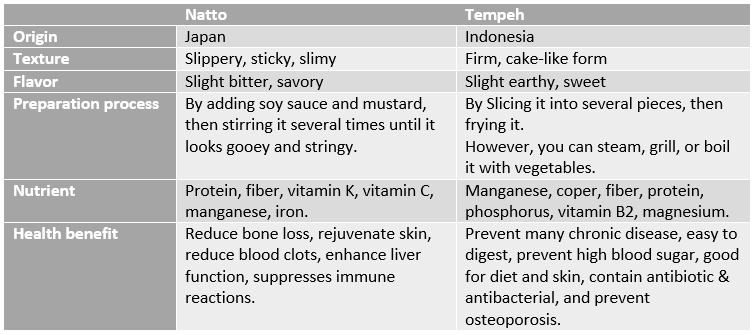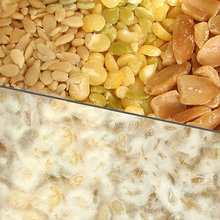Natto tempeh difference information
Home » Wallpapers » Natto tempeh difference information
Your Natto tempeh difference images are available in this site. Natto tempeh difference are a topic that is being searched for and liked by netizens now. You can Find and Download the Natto tempeh difference files here. Find and Download all free vectors.
If you’re looking for natto tempeh difference images information connected with to the natto tempeh difference interest, you have come to the right blog. Our website always gives you hints for viewing the maximum quality video and picture content, please kindly search and find more informative video content and graphics that match your interests.
Natto Tempeh Difference. It can be described as slightly sweet nutty and earthy. There is very little difference in fatty acid content in tempeh prepared with two different cultures. Unlike tofus bland flavor profile tempeh has a naturally nutty flavor. Natto is produced through fermentation of cooked yellow soybeans with Bacillus subtilis var.
 Tempeh Faqs From culturesforhealth.com
Tempeh Faqs From culturesforhealth.com
Meanwhile tempeh and natto are viands by themselves. The more mature the tempeh is the more vitamin B12 it contains. Nattōs daily need coverage for Iron is 74 more. There are several key differences between tofu and tempeh. Tempeh is rich in nutrients. This produces a viscous food with a distinct flavour and strong odour.
Although a little higher in calories tempeh is less processed than tofu and its healthier in general because it contains more protein and fiber than tofu.
The flavor is stronger as well. Tempeh is rich in nutrients. They are indeed very healthy for our body. It also has a very pungent odor that makes this dish an acquired taste. They just contain one enzyme extracted from natto. Though they are both made from soy most tofu is not fermented though the name originates with that word while tempeh is fermented.
 Source: nl.pinterest.com
Source: nl.pinterest.com
The surface of natto is covered by mucilaginous fluid consisting of polyglutamic acid and polyfructan which shows a thread forming ability. It can be described as slightly sweet nutty and earthy. There is very little difference in fatty acid content in tempeh prepared with two different cultures. However no bacteria is added and it has a sticky gelatinous coating with a cottage cheese-like texture and strong smell tempeh has almost no odor and is dry to the touch. 6613 Natto and tempeh.
 Source: pinterest.com
Source: pinterest.com
Visually Natto is slimy while tempeh is dense like a cake. It is made of fermented cooked whole soybeans. Tempeh is actually of Indonesian origin while natto as well as miso and tamari are part of Japanese cuisine. After discovering the taste and health benefits people began to wrap soybeans in leaves stored in warm places to make tempeh. Natto is a traditional food in Japan made from cooked soybeans fermented by Bacillus subtilis natto Watanabe et al 1991.
 Source: smartbreadmaker.com
Source: smartbreadmaker.com
Much like tempeh natto is fermented with a rich probiotic content making it good for digestion and gut health. Soybeans were packed and pressed into large sheets and one day fungi were found growing on them. Tempeh which originated in Indonesia is made from whole soybeans that are cooked fermented and molded into a block. Tempeh is rich in oleic and linoleic acids as raw soybean itself is one of the richest sources of these two fatty acids. The flavor is stronger as well.
 Source: educious.blogspot.com
Source: educious.blogspot.com
The more mature the tempeh is the more vitamin B12 it contains. The flavor is stronger as well. However it also absorbs other flavors well. Its made from soaking whole soybeans cooking them and then adding bacteria to the cooked beans so they can ferment. They are indeed very healthy for our body.
 Source: smartbreadmaker.com
Source: smartbreadmaker.com
Tempeh is rich in oleic and linoleic acids as raw soybean itself is one of the richest sources of these two fatty acids. Tempeh is actually of Indonesian origin while natto as well as miso and tamari are part of Japanese cuisine. There is very little difference in fatty acid content in tempeh prepared with two different cultures. Even more so than tempeh natto is definitely not for everybody. Tempeh may have more calories and fat content but Kanda says comparing two 100 gram servings is slightly misleading because 100 grams of tempeh will be more filling than 100 grams of.
 Source: fi.pinterest.com
Source: fi.pinterest.com
Fiber g in 12 cup. However unlike many other soy foods natto is fermented which accounts for many of its health-promoting properties. Tempeh is usually much more nutritious than tofu as. However it also absorbs other flavors well. 6613 Natto and tempeh.
 Source: smartbreadmaker.com
Source: smartbreadmaker.com
Although a little higher in calories tempeh is less processed than tofu and its healthier in general because it contains more protein and fiber than tofu. Compared to natto the word on the street is slightly different for tempeh and miso. Natto is a traditional food usually consumed at Japanese breakfast tables together with miso soup fish and rice. The natural tempeh fermentation process also makes the soya more digestible. Nattō is higher in Iron Zinc Copper Calcium and Manganese yet Tempeh is higher in Vitamin B3 Selenium Vitamin C Phosphorus and Vitamin B2.
 Source: pinterest.com
Source: pinterest.com
Both products are made from soybeans fermented with beneficial bacteria. Natto is a traditional food in Japan made from cooked soybeans fermented by Bacillus subtilis natto Watanabe et al 1991. It can be described as slightly sweet nutty and earthy. Natto and Tempeh they have things in common. Unlike tofus bland flavor profile tempeh has a naturally nutty flavor.
 Source: pinterest.com
Source: pinterest.com
They are indeed very healthy for our body. Even more so than tempeh natto is definitely not for everybody. 6613 Natto and tempeh. However unlike many other soy foods natto is fermented which accounts for many of its health-promoting properties. Natto is a traditional food in Japan made from cooked soybeans fermented by Bacillus subtilis natto Watanabe et al 1991.
 Source: id.pinterest.com
Source: id.pinterest.com
Natto is a traditional food usually consumed at Japanese breakfast tables together with miso soup fish and rice. Tempeh was discovered by accident in the Far East. The surface of natto is covered by mucilaginous fluid consisting of polyglutamic acid and polyfructan which shows a thread forming ability. It is also a generous source of nutrients such as calcium B-vitamins and iron. There is very little difference in fatty acid content in tempeh prepared with two different cultures.
 Source: in.pinterest.com
Source: in.pinterest.com
Sundaramadiji and Markakis showed that organoleptically tempeh scored best at. This produces a viscous food with a distinct flavour and strong odour. Natto is traditionally served as a topping for rice in miso soups or added to vegetables. Tempeh is rich in oleic and linoleic acids as raw soybean itself is one of the richest sources of these two fatty acids. Natto is a traditional food usually consumed at Japanese breakfast tables together with miso soup fish and rice.
 Source: youtube.com
Source: youtube.com
Tempeh is rich in oleic and linoleic acids as raw soybean itself is one of the richest sources of these two fatty acids. Tempeh was discovered by accident in the Far East. However it also absorbs other flavors well. With tempeh the soy beans are ground and formed into large patties. Although a little higher in calories tempeh is less processed than tofu and its healthier in general because it contains more protein and fiber than tofu.
 Source: pinterest.com
Source: pinterest.com
Natto and Tempeh they have things in common. The surface of natto is covered by mucilaginous fluid consisting of polyglutamic acid and polyfructan which shows a thread forming ability. 6613 Natto and tempeh. In addition tempeh is a good source of monounsaturated fats and contains no cholesterol. Both products are made from soybeans fermented with beneficial bacteria.
 Source: culturesforhealth.com
Source: culturesforhealth.com
Natto is a traditional food usually consumed at Japanese breakfast tables together with miso soup fish and rice. After discovering the taste and health benefits people began to wrap soybeans in leaves stored in warm places to make tempeh. The more mature the tempeh is the more vitamin B12 it contains. Natto is produced through fermentation of cooked yellow soybeans with Bacillus subtilis var. It is also a generous source of nutrients such as calcium B-vitamins and iron.
 Source: smartbreadmaker.com
Source: smartbreadmaker.com
A quick online search revealed numerous tempeh recipes to try such as barbeque tempeh sandwiches tempeh ratatouille vegetarian sloppy joes and more. 6613 Natto and tempeh. Nattōs daily need coverage for Iron is 74 more. Tempeh was discovered by accident in the Far East. However no bacteria is added and it has a sticky gelatinous coating with a cottage cheese-like texture and strong smell tempeh has almost no odor and is dry to the touch.
 Source: educious.blogspot.com
Source: educious.blogspot.com
However no bacteria is added and it has a sticky gelatinous coating with a cottage cheese-like texture and strong smell tempeh has almost no odor and is dry to the touch. Nattō is higher in Iron Zinc Copper Calcium and Manganese yet Tempeh is higher in Vitamin B3 Selenium Vitamin C Phosphorus and Vitamin B2. Natto is a traditional Japanese fermented soybean of which Itohiki-Natto is the most commonly consumed. Its made from soaking whole soybeans cooking them and then adding bacteria to the cooked beans so they can ferment. Natto is a traditional food in Japan made from cooked soybeans fermented by Bacillus subtilis natto Watanabe et al 1991.
 Source: smartbreadmaker.com
Source: smartbreadmaker.com
Although a little higher in calories tempeh is less processed than tofu and its healthier in general because it contains more protein and fiber than tofu. But in natto the individual beans are still distinguishable though quite soggy and sticky. Both products are made from soybeans fermented with beneficial bacteria. Natto is produced through fermentation of cooked yellow soybeans with Bacillus subtilis var. It also has a very pungent odor that makes this dish an acquired taste.
 Source: smartbreadmaker.com
Source: smartbreadmaker.com
It is also a generous source of nutrients such as calcium B-vitamins and iron. Even more so than tempeh natto is definitely not for everybody. Tempeh may have more calories and fat content but Kanda says comparing two 100 gram servings is slightly misleading because 100 grams of tempeh will be more filling than 100 grams of. Natto is also a living food and contains the highly beneficial probiotic enzyme nattokinase. The flavor is stronger as well.
This site is an open community for users to submit their favorite wallpapers on the internet, all images or pictures in this website are for personal wallpaper use only, it is stricly prohibited to use this wallpaper for commercial purposes, if you are the author and find this image is shared without your permission, please kindly raise a DMCA report to Us.
If you find this site beneficial, please support us by sharing this posts to your favorite social media accounts like Facebook, Instagram and so on or you can also bookmark this blog page with the title natto tempeh difference by using Ctrl + D for devices a laptop with a Windows operating system or Command + D for laptops with an Apple operating system. If you use a smartphone, you can also use the drawer menu of the browser you are using. Whether it’s a Windows, Mac, iOS or Android operating system, you will still be able to bookmark this website.

Category
Related By Category
- Just bikes magazine ideas
- Premium wave and scalp butter images
- Utv kbb images
- Forfora o pidocchi images
- Kenda tyres near me information
- We fix it ideas
- Does hair dye kill head lice information
- Deathfist pawn scalp information
- Phytopolleine scalp treatment review ideas
- Do hair straighteners kill lice ideas
